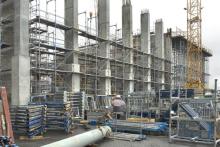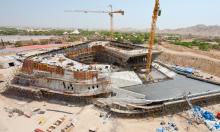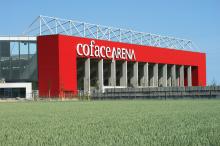
Construction of a new cancer centre in Germany has called for concrete not only to provide structural support but also protection against radiation
From 2010 up to 3000 patients a year will be able to undergo innovative particle therapy cancer treatment at a new specialist centre currently under construction in Marburg, Germany. The centre - only the third of its kind in the world - will use protons and carbon ions to treat tumours that would normally be difficult to combat using conventional medical techniques.
However, not only will the treatments available at the centre be cutting edge, the concrete being used to build the structure for the new hospital is also state of the art.
The client for the project is Rhön-Klinikum AG (RKA) from Bad Neustadt an der Saale and the facility is being built in cooperation with Siemens Medical Solutions on the premises of the university clinic Gießen/Marburg, a subsidiary of RKA. The new centre comprises a one-floor treatment wing with connected offices, located on a greenfield site close to the existing buildings of the university clinic.
"A pyrite concrete of such quality and with this bulk density has never been used before in Germany and, to my knowledge, it has not been used elsewhere in Europe either," said Cemex plant group manager Ralf Schumacher who manages the site that is suppyling the ready mixed concrete to main contractor Hentschke Bau GmbH, a subsidiary from Ichtershausen.
Cemex supplied three deliveries each 80m3, with a bulk of 430tonnes of concrete from its ready mixed concrete plant Lahntal-Goßfelden. The longest of the three technically complex concrete pours took the contractor 26 hours to complete.
The pyrite concrete with a tensile strength class C 20/25 reaches a bulk density of at least of 5.2tonnes/m3 - more than the double of normal concrete. Besides cement CEM III/B 32.5 N-NW/HS from Cemex's Schwelgern plant, the mix also included a concrete plasticiser from Cemex Admixtures. Heavy additives form part of the recipe with iron ore hematite and three fractions of steel granulate, with a granulation of 0 to 8mm. This recipe - among others approved by the International Atomic Energy Agency and experts of TÜV Bavaria - hinders the uncontrolled penetration of the highly intensive particle rays to the outside.
The pyrite concrete sections of the building are 4.5m high and 1 to 2.3m thick. Their outline follows the irregular forms of the accelerator plant and they are encased with additional cladding of shield concrete C 30/37. As a result the wall thickness in the critical areas is up to 4m deep.
During the development stage of the mix design, Hentschke Bau GmbH and Cemex's concrete technologists directed special attention to the balance between high bulk density and sufficient handling ability.
"In a week-long intensive development process, we succeeded in exactly setting the bulk density," explained Cemex test centre manager Carsten Becker. "The 5tonnes of manufactured concrete contains 4tonnes of steel. Despite the required fresh and compact bulk density, we had to achieve a concrete that could be practically used without forming cavities, while still meeting the specification. The additives and the steel granulate also needed to spread evenly in the matrix and not sink due to their high density.
"We checked the theory through lab tests since practical tests would have been too complex and costly. The tests carried out on this basis were faultless and to our customer's satisfaction."
On site
The contractor is using formwork formed from expanded metal with millimetre-wide pores. This type of formwork was selected for quality assurance - it allowed workers to make visual checks during the pour and ensure that the sludges leaked evenly at every position to give a finished construction free of bubbles and cavities.
Cemex designed the pyrite concrete with an F3 consistency to give a slump of 450mm to allow the structure to be poured continuously without compromising the lower levels through excess pressure.
By means of moisture measuring of the aggregate granulation, the water content of the water-cement-hematite-mix could be checked and adjusted exactly prior to delivery. A mix with too high a water content would not have met the quality demand, but an adequate amount of chemically bound water is required for an effective radiation protection.
Since the steel component of the mix was exempt from moisture measuring, it could be loaded directly into the truck mixer and be mixed with the other concrete ingredients there. Schumacher together with the plant's maintenance team drew up a special procedure: after a truck mixer was loaded with the concrete, the driver manoeuvred the truck below the specially designed loading station over which a crane positioned a Big Pack with 2.1tonnes of steel granulate. The Big Pack was then opened to allow the steel to slide over a dosing device into the truck. In order not to overburden the truck hydraulic, the load volume was limited to 2m3 of heavy concrete - each containing steel granulate from two big Packs.
Up to six men were engaged in the mixing and quality assurance of the high density concrete in the plant and two material inspectors from Cemex also carried out concrete quality checks on site. The contractor also prepared a sample cube from each load for compliance testing and according to Cemex, all the material supplied met the specification.
In addition to the innovative pyrite concrete, Cermex Deutschland will supply the project with another 25,000m3 of conventional ready mixed concrete for the main building constructions. All walls within the treatment wing are built with a 4m thick shield of concrete, while the ceilings are up to 2m deep.
Material for the main building work is being produced at plants in Marburg and Stadtallendorf, as well as Lahntal-Goßfelden, to meet the demands of the project.
Before work on site started, all concrete types were scrutinised by the controlling bodies and authorities. These tests far exceed the scope of the concrete technology and they include chemical and physical parameters in order to verify the radiation protection attributes.
Work on the concrete elements of the building are expected to be completed this year to make way for fitting out of the new centre which is due to receive its first patients in two year's time.








